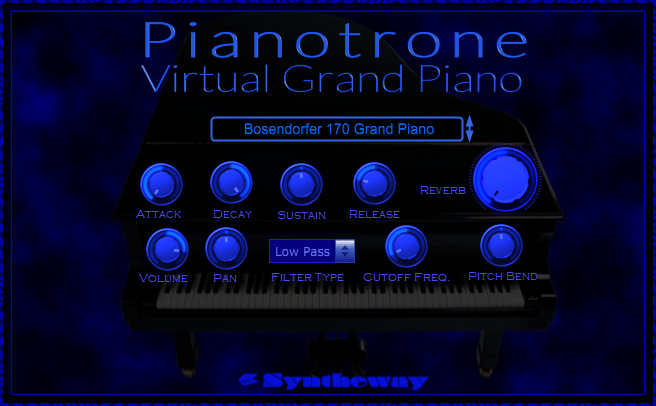Pianotrone Virtual Grand Piano
Audio Unit, VST and
VST3 Plugins for Mac


Pianotrone is a grand
piano emulation based on the Bösendorfer 170, Kawai 600,
Steinway Model C, Yamaha C5 and C7 acoustic grand pianos
models.
Available
for macOS as plugin in
Audio
Unit (.component), VST (.vst) and VST3 (.vst3) formats.
The Audio Unit
Component, VST and VST3 plug-ins requires of a MIDI
Controller to play this virtual instrumentof and a
compatible host, digital audio workstation (DAW) or MIDI
sequencer that supports Audio Units and VST technology. They
can be "plugged in" to process audio by applications such as
Logic Pro, GarageBand, Cubase, Ableton Live, REAPER, Studio
One Professional, Ardour, MainStage and Digital Performer
among others.
The software
package is distributed via Internet in an Apple Disk Image
DMG file and compatible with macOS and all previous OS X.
Please, test extensively the
demo version of this product in your host to make sure
there are no misbehaviors before
purchasing.
Features
• Quick selector to switch between different preset sounds:
|
# |
List of
Preset Sounds / Demo
↓ |
 |
|
1 |
Bösendorfer 170 Grand Piano |
 |
|
2 |
Kawai 600
Grand Piano |
 |
|
3 |
Steinway
Model C Grand Piano |
 |
|
4 |
Yamaha C5 Grand Piano |
 |
|
5 |
Yamaha C7 Grand Piano |
 |
|
•
ADSR envelope generator with Attack, Sustain, Decay and Release parameters:
Ø Attack
determines the time it takes for the note to get to the maximum
level.
Ø Decay
determines the time it takes for the note to go from the maximum
level to the sustain level (controlled by Sustain).
Ø Sustain
determines the level of the sound is played at while the note is held
(after the other envelope states, Attack and Decay, have been
completed).
Ø Release
determines the time it takes for the note to fall from the
sustain level to zero (silence) level when it is released.
• Pitch Bend: The Pitch Bend knob directly changes the pitch of the selected
instrument.
Ø Pitch
Bend center position: is normal pitch.
Ø Pitch
Bend down: Specifies the amount of pitch change that will occur
when the pitch bend/modulation lever is moved to the left.
Ø Pitch
Bend up: Specifies the amount of pitch change that will occur
when the pitch bend/modulation lever is moved the right.
• Reverb built-in: provides a spaciousness and depth to simulate the sound
reflections from walls, floors and ceilings following a sound created in an
acoustically reflective environment. Small rooms can be modeled as well as
large spaces.
• Filter Type. Combo box to switch between the following options:
Ø Low
Pass (LPF): a filter that passes signals with a frequency lower
than a certain cutoff frequency and attenuates signals with
frequencies higher than the cutoff frequency.
Ø High
Pass (HPF): a filter that passes signals with a frequency higher
than a certain cutoff frequency and attenuates signals with
frequencies lower than the cutoff frequency.
Ø None:
No filter is applied.
Ø Cutoff
Frequency Filter: Sets the cutoff frequency for the low pass and
high pass filters.
• Volume: Adjusts the volume of the instrument.
• Panning potentiometer control: Set the panning of the instrument. Adjusts
the stereo pan position of the signal output, which determines how much of
signal is sent to the left and right channels.
• MIDI CC Automation: Implementation of MIDI Continuous Controller
parameters for use with external hardware control via DAW, such as:
expression (CC#11), volume (CC#7), pan (CC#10), balance (CC#8), filter
cutoff (CC#74), ADSR (Attack: CC#73, Decay: CC#75, Sustain: CC#76, Release:
CC#72) and reverb depth (CC#91).


